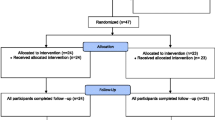Abstract
Balance is an important criterion in assessing health. The lack of exercise of most young people leads to an increased risk of balance abnormity as part of irregular lifestyles. This paper examines the effect of training with an interactive exercise game on young people’s balance after 1 month. The experiment and analysis followed a three-stage design. Initially, gait function testing was conducted to determine a datum point for the situation at the outset; next, a Gym Top balance trainer was used for training; finally, balance was measured with a force plate and center of pressure signals were collected. Differences in balance before and after training were analyzed with multiscale entropy and multivariate multiscale entropy methods. 12 healthy young people were recruited for the experiment. Statistical analysis of the gait test observations revealed that the number of times of standing and sitting increased significantly after training. Multiscale entropy analysis showed that the multiscale entropy curve was higher after training than before training. Multivariate multiscale entropy analysis showed that balance after training was greater than before training. These results demonstrate that the balance of young people was improved after training with a balance trainer eight times a month.









Similar content being viewed by others
Explore related subjects
Discover the latest articles, news and stories from top researchers in related subjects.References
Adlerton AK, Moritz U (1996) Does calf-muscle fatigue affect standing balance? Scand J Med Sci Sports 6(4):211–215. doi:10.1111/j.1600-0838.1996.tb00093.x
Ahmed MU, Mandic DP (2012) Multivariate multiscale entropy analysis. IEEE Signal Process Lett 19(2):91–94. doi:10.1109/LSP.2011.2180713
Busa MA, van Emmerik RE (2016) Multiscale entropy: a tool for understanding the complexity of postural control. J Sport Health Sci 5(1):44–51. doi:10.1016/j.jshs.2016.01.018
Cao L, Mees A, Judd K (1998) Dynamics from multivariate time series. Phys D 121(1–2):75–88. doi:10.1016/S0167-2789(98)00151-1
Clausius R (1850) Über die bewegende Kraft der Wärme und die Gesetze, welche sich daraus für die Wärmelehre selbst ableiten lassen. Ann Phys 155(3):368–397
Costa M, Goldberger AL, Peng CK (2002) Multiscale entropy analysis of complex physiologic time series. Phys Rev Lett 89(6):068102. doi:10.1103/PhysRevLett.89.068102
Costa M, Peng CK, Goldberger AL, Hausdorff JM (2003) Multiscale entropy analysis of human gait dynamics. Phys A 330(1):53–60. doi:10.1016/j.physa.2003.08.022
Fitzgerald D, Trakarnratanakul N, Smyth B, Caulfield B (2010) Effects of a wobble board-based therapeutic exergaming system for balance training on dynamic postural stability and intrinsic motivation levels. J Orthop Sports Phys Ther 40(1):11–19. doi:10.2519/jospt.2010.3121
Gruber AH, Busa MA, Gorton Iii GE, Van Emmerik RE, Masso PD, Hamill J (2011) Time-to-contact and multiscale entropy identify differences in postural control in adolescent idiopathic scoliosis. Gait Posture 34(1):13–18. doi:10.1016/j.gaitpost.2011.02.015
Islam MM, Nasu E, Rogers ME, Koizumi D, Rogers NL, Takeshima N (2004) Effects of combined sensory and muscular training on balance in Japanese older adults. Prev Med 39(6):1148–1155. doi:10.1016/j.ypmed.2004.04.048
Long BC, Haney CJ (1988) Long-term follow-up of stressed working women: a comparison of aerobic exercise and progressive relaxation. J Sport Exerc Psychol 10(4):461–470. doi:10.1123/jsep.10.4.461
Niu H, Wang J (2015) Quantifying complexity of financial short-term time series by composite multiscale entropy measure. Commun Nonlinear Sci Numer Simul 22(1):375–382. doi:10.1016/j.cnsns.2014.08.038
Pincus SM (1991) Approximate entropy as a measure of system complexity. Proc Natl Acad Sci USA 88(6):2297–2301. doi:10.1073/pnas.88.6.2297
Raglin JS (1990) Exercise and mental health. Sports Med 9(6):323–329. doi:10.2165/00007256-199009060-00001
Richman JS, Moorman JR (2000) Physiological time-series analysis using approximate entropy and sample entropy. Am J Physiol Heart Circ Physiol 278(6):H2039–H2049
Shih CH, Shih CT, Chiang MS (2010) A new standing posture detector to enable people with multiple disabilities to control environmental stimulation by changing their standing posture through a commercial Wii Balance Board. Res Dev Disabil 31(1):281–286. doi:10.1016/j.ridd.2009.09.013
VanSiooten PH (1973) Performance of selected motor coordination tasks by young boys and girls in six socioeconomic groups. Dissertation, University of Indiana
Waddington GS, Adams RD (2004) The effect of a 5-week wobble-board exercise intervention on ability to discriminate different degrees of ankle inversion, barefoot and wearing Shoes: a study in healthy elderly. J Am Geriatr Soc 52(4):573–576. doi:10.1111/j.1532-5415.2004.52164.x
Wu WP, Hsu NY, Wang LI (2011) Effects of virtual reality based standing posture training on static posture balance through a Wii fit yuga game. Sports Coach Sci 23:43–56. doi:10.6194/SCS.2011.23.04
Zheng GB, Jin ND (2009) Multiscale entropy and dynamic characteristics of two-phase flow patterns. Acta Phys Sin 58(7):4485–4492. doi:10.7498/aps.58.4485
Zhu L, Jin ND, Gao ZK, Zong YB (2011) Multi-scale cross entropy analysis for inclined oil–water two-phase countercurrent flow patterns. Chem Eng Sci 66(23):6099–6108. doi:10.1016/j.ces.2011.08.034
Author information
Authors and Affiliations
Corresponding author
Rights and permissions
About this article
Cite this article
Wang, CC., Jiang, B.C. & Lin, WC. Evaluation of effects of balance training from using wobble board-based exergaming system by MSE and MMSE techniques. J Ambient Intell Human Comput 9, 1745–1754 (2018). https://doi.org/10.1007/s12652-017-0594-1
Received:
Accepted:
Published:
Issue Date:
DOI: https://doi.org/10.1007/s12652-017-0594-1




